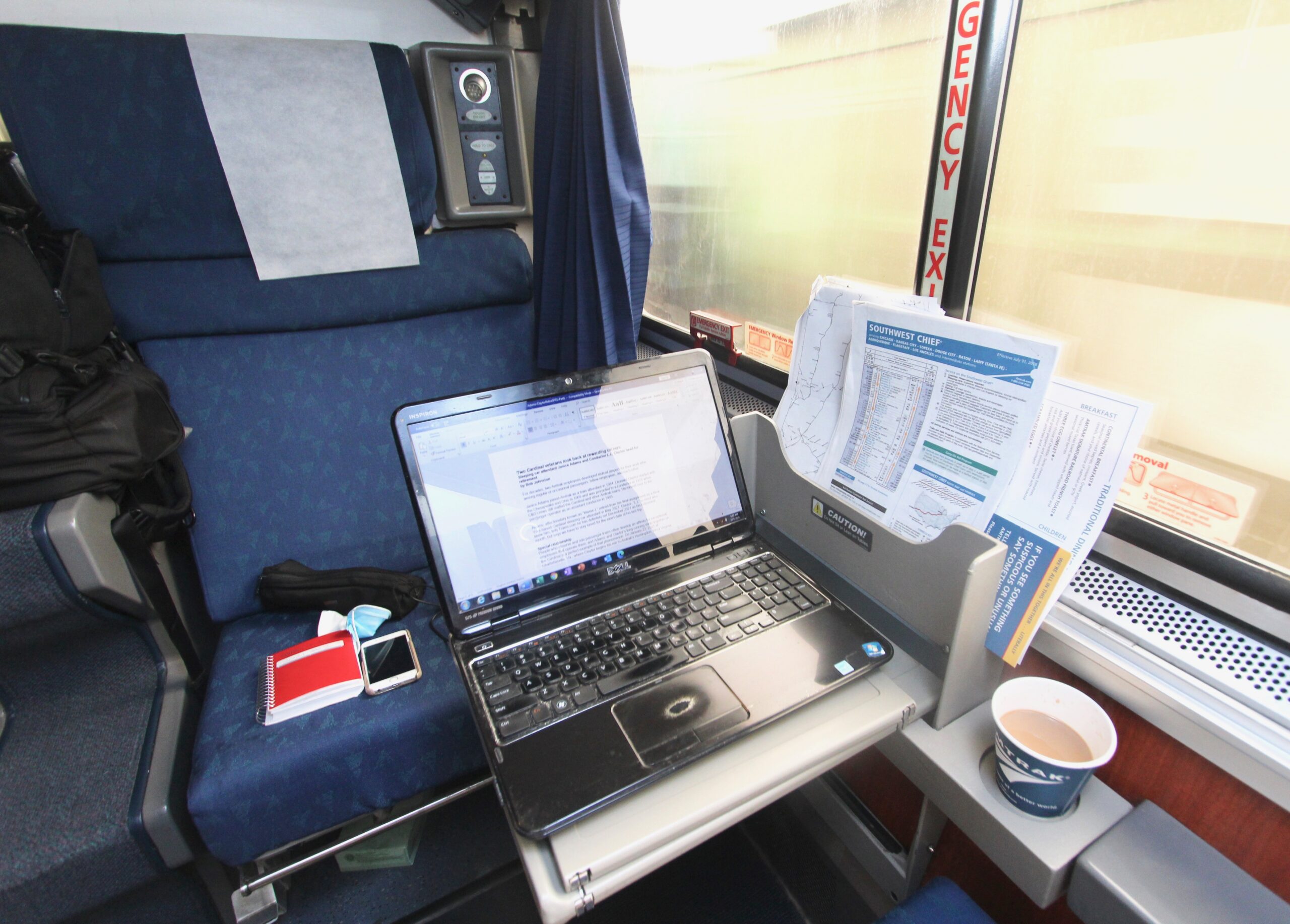
In the not-too-distant past, Amtrak provided route guides and timetables with a wealth of information about not only sights and points of interest along its routes, but also what to expect on each train: Is there checked baggage service? Are pillows available for coach passengers? What kind of dining options are offered?
Through 2017, Amtrak managements through 2017 understood its “product” was not simply point-to-point transportation but something uniquely different from travel modes that require seat belts, or where keeping eyes on the road for safety’s sake largely precludes doing anything else.
Amtrak officials tell Trains.com an electronic, real-time version of the previous printed schedules is under development. Even when that arrives, it is unlikely travelers not familiar with long-distance train travel will know what to bring along and how to make a journey more enjoyable.
Though not an exhaustive list (veteran rail voyagers develop their own, based on experience), here are some suggestions:
Must haves (photo at top)
The laptop is optional, but whether you are in a roomette like this one on the Southwest Chief or a coach seat, it’s best to be armed with a printed timetable and maps to serve as a scorecard explaining what is rolling by—and when. A handy place to keep them in roomettes is next to the window behind the fold-down table.
For now, schedules can be accessed via a Rail Passengers Association link or the Juckins website. Detailed rail maps, such as those from the British firm Steam Powered Videos (SPV), are available for sale from the Kalmbach Hobby Store, but highway road atlas maps of any kind are better than nothing at all. Not affiliated with Amtrak is a route guide website, but these and other sites often don’t provide the “what to look for” anecdotes that Amtrak’s long-gone, train-specific brochures once did.
On the seat is a notebook — always handy to help recall otherwise forgotten details after a trip. As for the cell phone, its “you are here” map function is indispensable, as is the Amtrak app’s “train status” information. Speedometer apps may also be of interest, but all apps that depend on a decent wireless signal may be of limited use on rural portions of many routes; overnight trains in the west aren’t Wi-Fi-equipped. There are often hours-long stretches where the dreaded “no service” advisory pops up.
Luggage
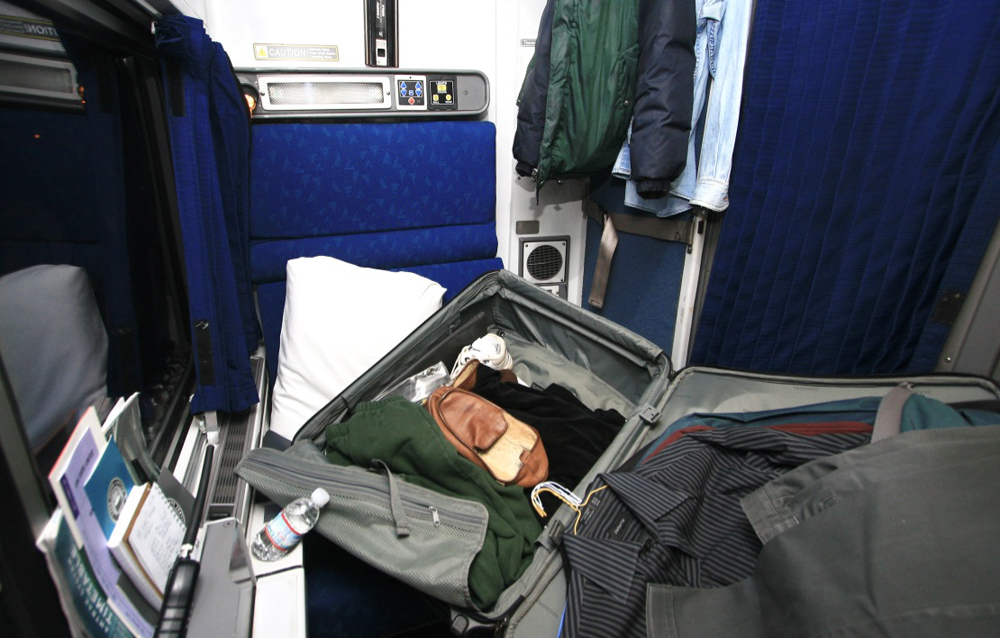
Space will be limited: Don’t expect a hotel room. First-time sleeping car passengers are surprised to learn how little space there is to unpack everything needed overnight in roomettes in both bilevel Superliners and single-level Viewliners. Bedrooms in both cars aren’t much better, especially when the bedroom’s larger bed has been converted from a sofa. Nevertheless, the first order of business is to unpack toiletries and the next day’s attire. The photo from a Lake Shore Limited Viewliner roomette illustrates the challenge. It was taken in 2009 when Amtrak still provided timetables and route guides; the scanner is also handy for directly obtaining details from the train crew as to why a train may be stopped.
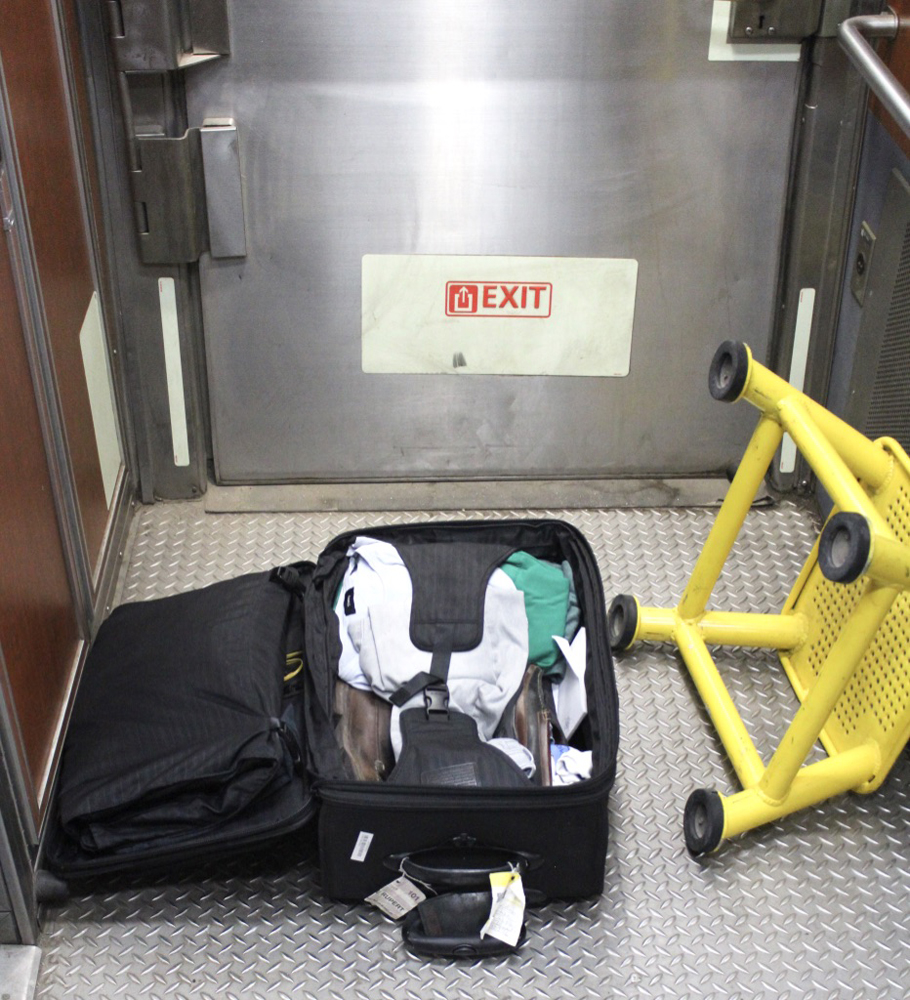
An alternative is to take the task “outside,” as shown at right — that is, to an area like the lower level near the door of this Superliner car where the bag can be opened and rearranged. Perhaps not the most sanitary solution, this can obviously only be attempted after the train has left the station and there is no foot traffic in the area.
Another option is to rearrange on the upper berth (as seen below in a Silver Meteor Viewliner roomette). Superliner rooms, with limited clearance as a result of being stacked on two levels, don’t offer enough headroom on a top berth for passengers to sit up in bed, so the task must be handled while standing on the roomette’s floor.
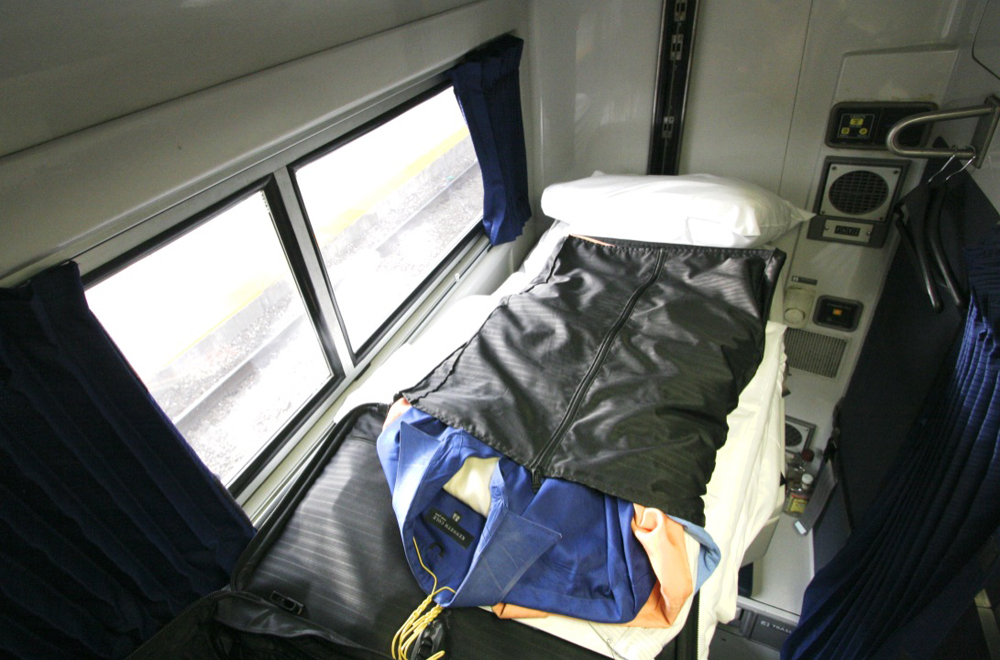
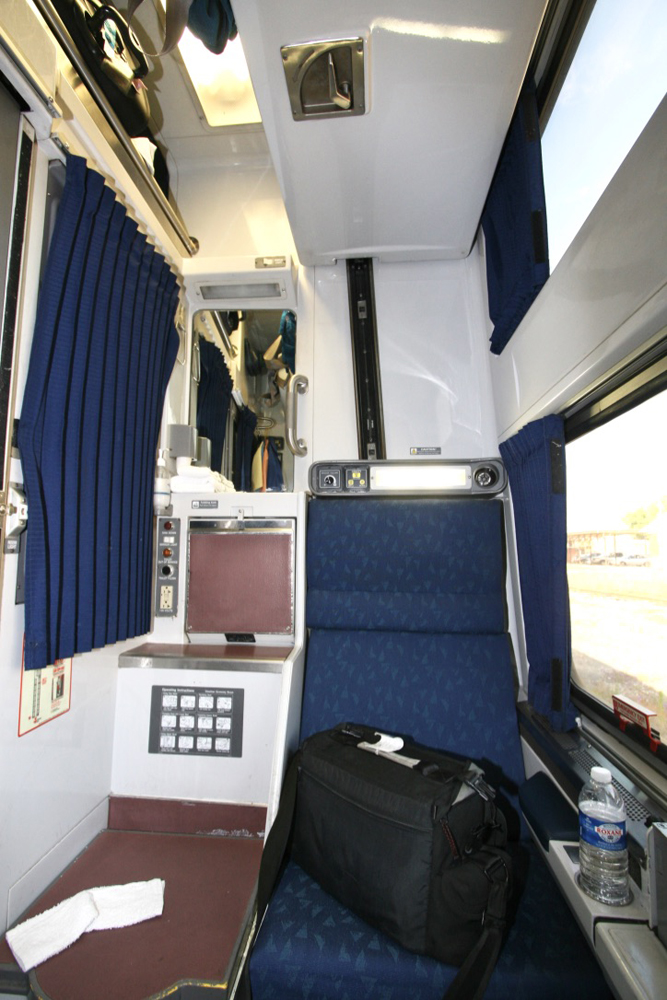
In a Viewliner, there is a small luggage compartment opposite the upper berth (top left in the photo at left), which is a handy place to store small suitcases that fit there, as well as other items needed during the trip, without cluttering the rest of the room. However, the berth must be lowered to get the suitcase up, and this can be a challenge with heavy luggage. Bags may or may not also fit under the seat, but there is nowhere else on Viewliners to store them unless the attendant offers to put large suitcases in an empty room or the baggage car.
Other than a narrow closet (in Superliner Is) or an recessed wall for hanging clothes (Superliner IIs), Superliner storage space is relegated to the lower level of each car. With Amtrak eliminating checked baggage at all but its largest or endpoint stations, this area tends to get jammed. Luggage is generally secure, although on one eastbound Empire Builder trip a few years ago a Chicago passenger’s suitcase was mistakenly taken off the train at St. Paul. A security guard at the airport asked for the owner to retrieve it, but he had just departed LaCrosse, Wis. The St. Paul Amtrak agent rescued it and put it on the next day’s train to Chicago.
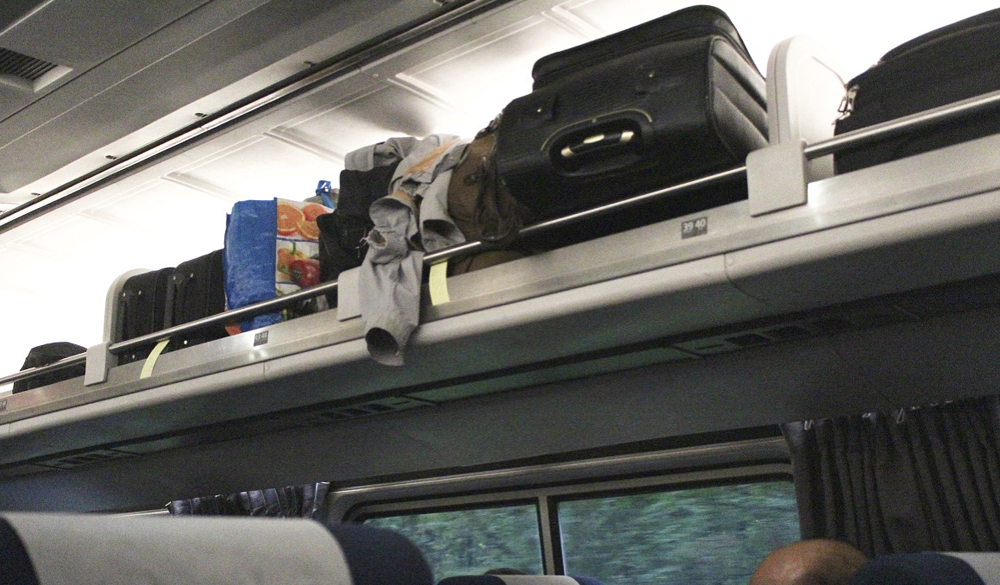
The inability to check luggage to most destinations is a significant problem for single-level coach travelers. The end-of-car luggage tower, if the car has one, quickly fills up. So most everything has to go on the overhead luggage rack, as seen above on the Lake Shore Limited’s Boston section in 2019.
More hints
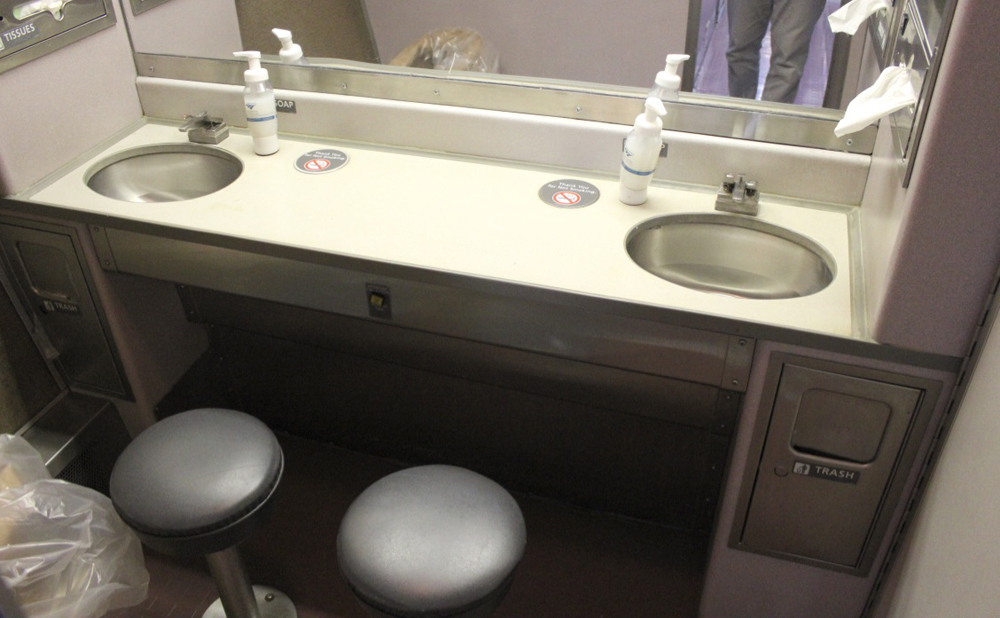
‘Secret’ room: The only personal space for single-level coach passengers to perform overnight and next-morning functions is at two bathrooms in each car, where reports indicate that Amtrak has stepped up cleaning procedures. But Superliner coaches have additional bathrooms on the lower level; one of them, as shown above, incorporates this “lounge” at the end of the lower hall opposite the luggage racks.
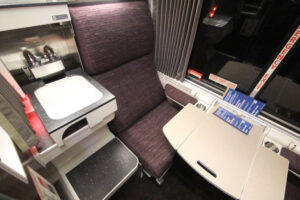
Be prepared for trips to the restroom: Sleeper passengers riding the Lake Shore, Silver Meteor, and Silver Star (and soon perhaps the Crescent and Cardinal) may be assigned a Viewliner II car. Roomettes in these new cars, as shown at left, do not have toilets under the fold-down sink, so be prepared to use facilities “down the hall.” Superliner roomettes also do not have toilets, so it is a good idea to pack appropriate clothing and sandals for any nocturnal visit. Amtrak briefly offered slippers in a 2018 amenity package, but that is no longer the case.
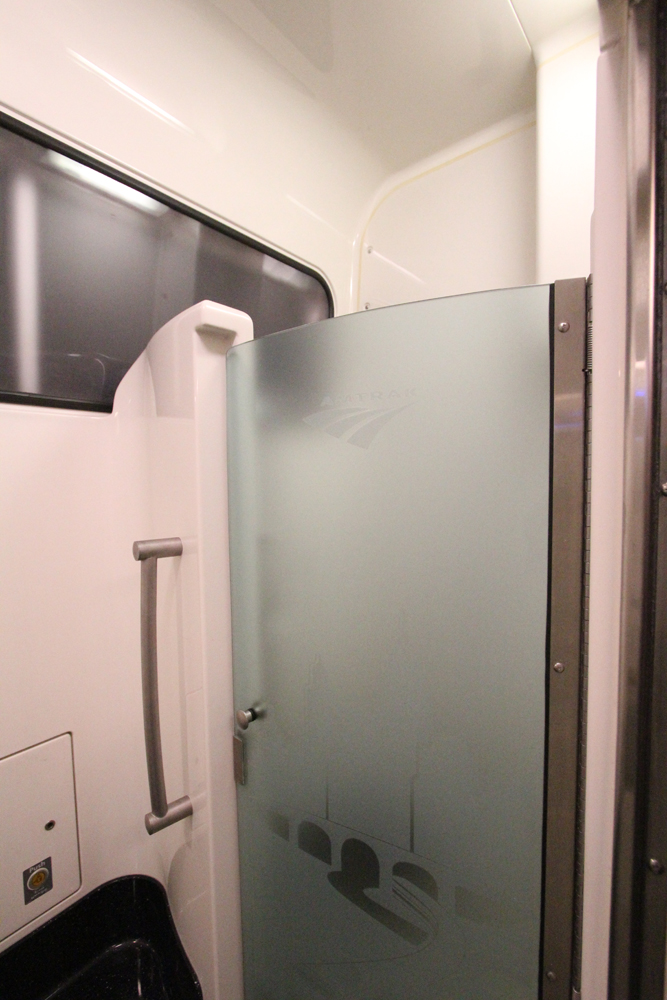
Shower anyone? Sandals are also useful for a trip to the shower. The Viewliner II version shown at right is much improved over its predecessor, but the lower-level Superliner showers are also relatively spacious compared to the in-bathroom showers in Viewliner and Superliner bedrooms. Bring shampoo, pack a small hair dryer, and make sure the attendant has supplied towels before you enter. There may be a wait for your turn prior to morning arrivals.
Making a splash: Water in Viewliner fold-down sinks, as shown below, will likely slosh out of the bowl if filled too full. The faucets have been adjusted for less forceful water flow, compared to early iterations, but be careful. And don’t expect to see anything come out of that “ice water” tap on Viewliner I cars; those lines were disconnected about 20 years ago. A common mistake first-timers make is resting something like a toothbrush or wristwatch on the sink, then folding it up.
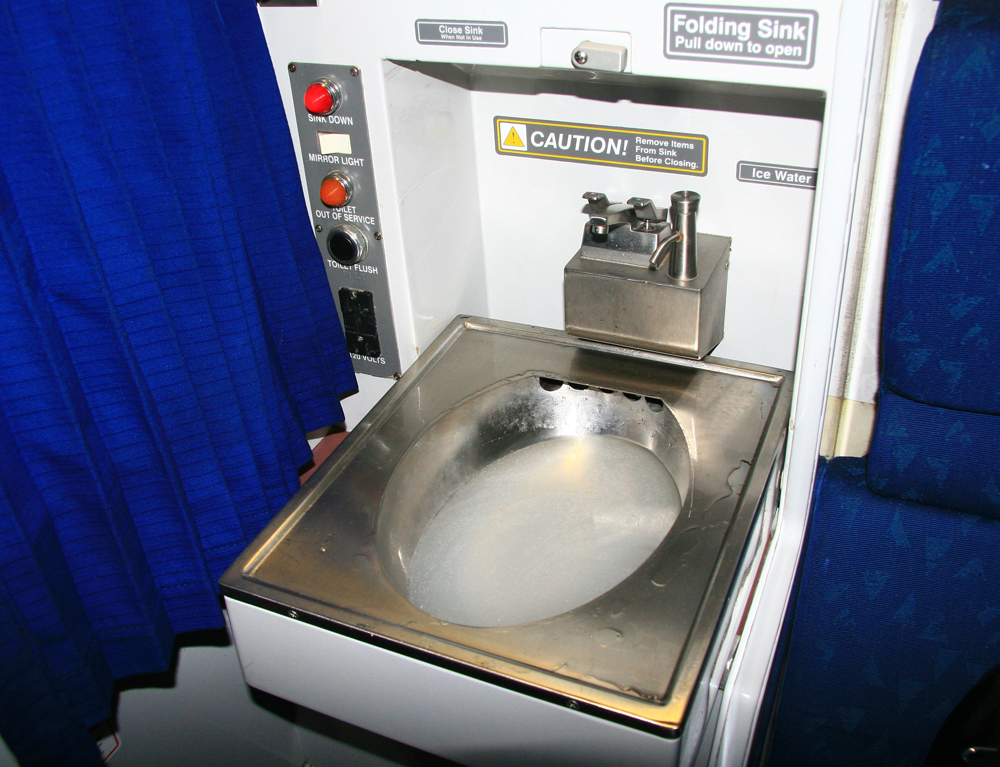
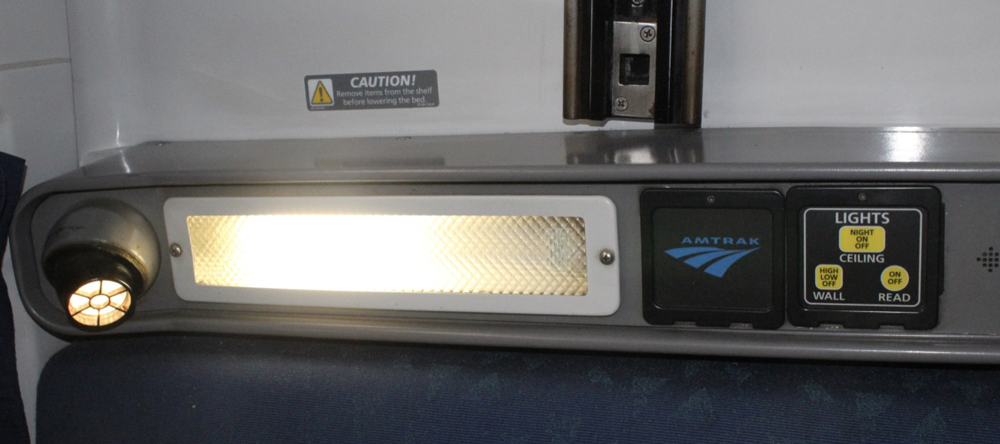
Switch mystery: Compared to dimly-lit Superliner rooms, there is plenty of light in Viewliners, but figuring out how to turn operate lights in Viewliner I rooms, as shown at right, can be puzzling. The square “wall” button refers to the fluorescent light, and the circular “read” button turns the round spotlight on and off. Be careful not to put anything on the shelf over this unit or a similar installation in Superliners, because a lowered upper berth will crush everything resting there. Cell phones are common victims.
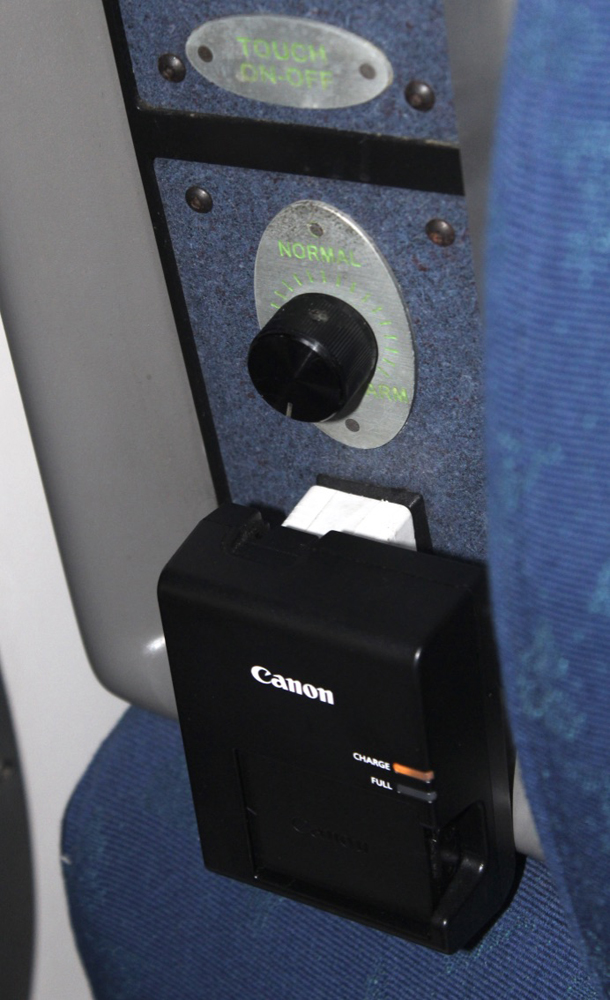
Silencing rattles: After decades of use, aging sleeping cars have developed loose-fitting doors, both to the outside hall and on connecting doors between bedrooms. This can be annoying when shaking inevitably occurs overnight. While many experienced travelers pack a roll of duct tape, a sock or towel jammed in the door usually does the trick.
Charging challenge: Every room and coach seat has at least one 110-volt socket with which to charge personal electronics. Cords always plug in without a problem, but some chargers have attached plugs, as shown at right. Because sockets on Superliner I sleeping cars are recessed, it’s always a good idea to bring along a three-prong adapter that effectively extends the socket out so the device is able to plug in.
As noted, this is by no means a complete list of tips, but Trains.com readers inevitably will be able to contribute additional suggestions. Fire away!







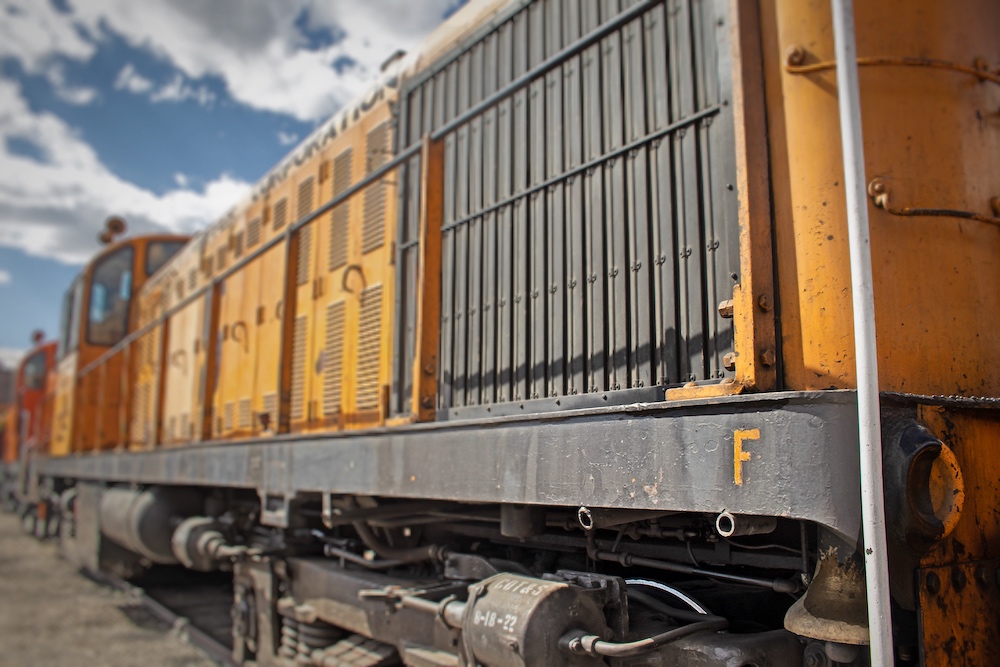
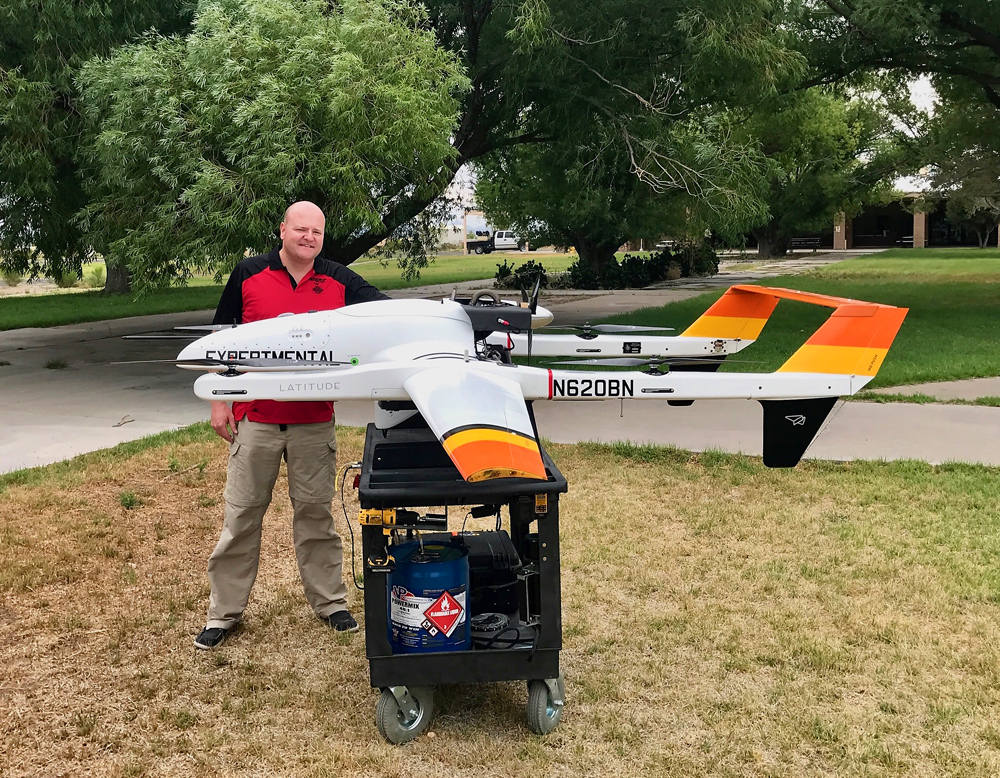




Almost forgot. If you’re handy, take a small tool kit or set of screw drivers to make minor repairs. Didn’t need them much, but they came in handy on a couple of occasions to fix minor annoyances.
When riding in the sleepers, take a few mesh see-thru bags and some straps with buckles. You can hang the bags in several places from the ceiling and bed. Segregating personal items (wallet, phone), toiletries, etc into different bags makes them easy to find when you need them, especially in the dark early morning hours.
And, as hinted in previous posts, if you pack carefully, you can leave your “land” luggage in the luggage racks below (with cable locks) and just take a light soft-sided carry-on up to the sleeper with what you need for 2 -3 days & nights.
Re: “In the not-too-distant past, Amtrak provided route guides and timetables with a wealth of information about not only sights and points of interest along its routes,…”
If you can find one, get a copy of the book “Rail Ventures”. This was published by Rail Ventures Publishing Co. P. O. Box 1877 Ouray, CO 81427. There were 6 editions: 1982, 1985, 1988, 1990, 1992, and 1994. I have them all except the 5th. They are out dated now, but still contain a wealth of information about what you are seeing along the route(s). They even include route guide information for Canada and Mexico passenger trains. Look for a copy online or at used book stores.
1. If you like reading in bed, which is great on a sleeper train, I recommend bringing a blowup pillow. Amtrak provides a couple of tiny pillows, not enough to support one’s back.
2. Between me and my wife we have five devices that need charging, but the Amtrak sleeper has only one outlet. So we bring an extension cord or a power center that provides multiple outlets.
I completely agree with Robert’s comments, hilarious and so true about setting your expectations. That’s what I told my wife when we drove down to Trinidad, CO to catch the Chief for a long weekend in Santa Fe. Would our return train be on time, or dump us in Trinidad hours (if not days) late? It’s all part of the experience. I shouldn’t have worried. We arrived about an hour late, but my car was another matter. The passenger side window was broken out. So much for the safety of small town stations. They made off with a lime green coffee mug, and we rode off to Walmart for plastic and duct tape. It had been a good trip.
As for essentials, bring snacks. Lots of snacks. They may end up being dinner, or survival rations when you’re really late and there is nothing left onboard but ketchup packets.
Search the web for Amtrakistan for a good read on the experience of long distance trains.
There is a grim humor in both the article and the comments and it is all true. I have traveled many times in Superliner sleepers and definitely prefer the deluxe bedroom type, so long as you do not get Bedroom A, which is significantly smaller than the others of that type. Keeping expectations low is a required state of mind if you want to enjoy your trip. If I could add one suggestion it would be to bring or ask for an extra blanket. As a person with a wool allergy, I appreciate today’s synthetic Amtrak blankets, but they are awfully thin. And, I always bring a roll of masking tape along- seems strange, but Amtrak travel is no place for amateurs.
Really Useful. Now I haven’t ridden an AMTK sleeper since 2005 (my only SuperLiner trip Washington-Chicago); previously I did Boston-DC and back in 2000 in the room with a shower-stall (you sat on the closed toilet seat and used a hand-held squirter–it worked & I washed my hair), and a Viewliner in 1998 Boston-Toledo-NYP. All previous AMTK sleeper experience was with Heritage Sleepers going back to 1979. (All private car trips were in Heritage-style sleepers including sections in Canada on VIA.) OK, one night in a Liegewagen on the Deutsche Reichsbahn Leipzig-Duesseldorf in 1991. Generally, spleepers beat most hotels on service. So I’m looking forward to doing Boston-DC in a sleeper to visit my sister down there. Will cost Big Bucks but everything does these days! Any reviews on the Night Owl’s sleeper service?
On our western train trips we take our cigarette pack sized ATT hot spot along and get good WiFi for a majority of the trips.
Also, we always book a double bedroom or even a suite. But use the downstairs shower. Much more spacious than the toilet shower in the room.
DOB J
I find it encouraging that this is written for folks who haven’t been doing this for years, or haven’t done it for many years. On the same note, there are numerous Youtube videos available for non-railfans, encompassing specific long-distance routes, and the details of life aboard a sleeper.
Excellent, truthful, and incisive article.
With experience on the Coast Starlight, Empire Builder, Silver Star, and Silver Meteor, the following points may add to this font of wisdom.
-With some exceptions I have found that the crews east of the
Mississippi tend be noisier at night.
-In terms of comparable comfort a roomette is the best mode for these trains. If you must use coach, bring a mask, ear plugs, and an eye mask. I would suggest these for a roomette also.
-Tipping the car attendant on the first night and at the end of
the trip goes along way.
– Gregariousness, addressing by name,
(especially in this age of rude), and a smile to the staff and
crew members, is as good as a tip. I always thank each one I
see when I am deboarding.
– With exceptional service, both good and bad, I make a note of the crewmembers name, position train #, and date. I give that feedback to Amtrak.
-Don’t assume help, sometimes you need to ask.
After reading this article I think Bob Johnston should be congratulated for telling the truth. This certainly doesn’t present a pretty picture of Amtrak accommodations. This does not include the inevitable late (sometimes very late) trains, rude and surly employees, rough track, difficult parking at downtown stations, lack of rental car facilities at all but the most urban stations (try Enterprise but their business hours may not always be extensive). I always tell new long distance Amtrak riders to not expect accommodations and service like at a full service hotel or cruise ship, to pack more patience than clothes, bring an unlimited sense of humor, never plan anything the day of your expected arrival, don’t plan on a same day connection in Chicago (or anywhere else for that matter unless there are multiple trains to your destination), and most importantly never, ever take anyone you love and expect to see again (and is not a railfan) with you. All of that being said, try to relax and enjoy your trip. After tens of thousands of miles on every Amtrak long distance train I can say that it isn’t all bad and some of it is quite good if you go with low expectations. You might be surprised. Things go right once in awhile. PS. That charging challenge suggestion is spot on!!